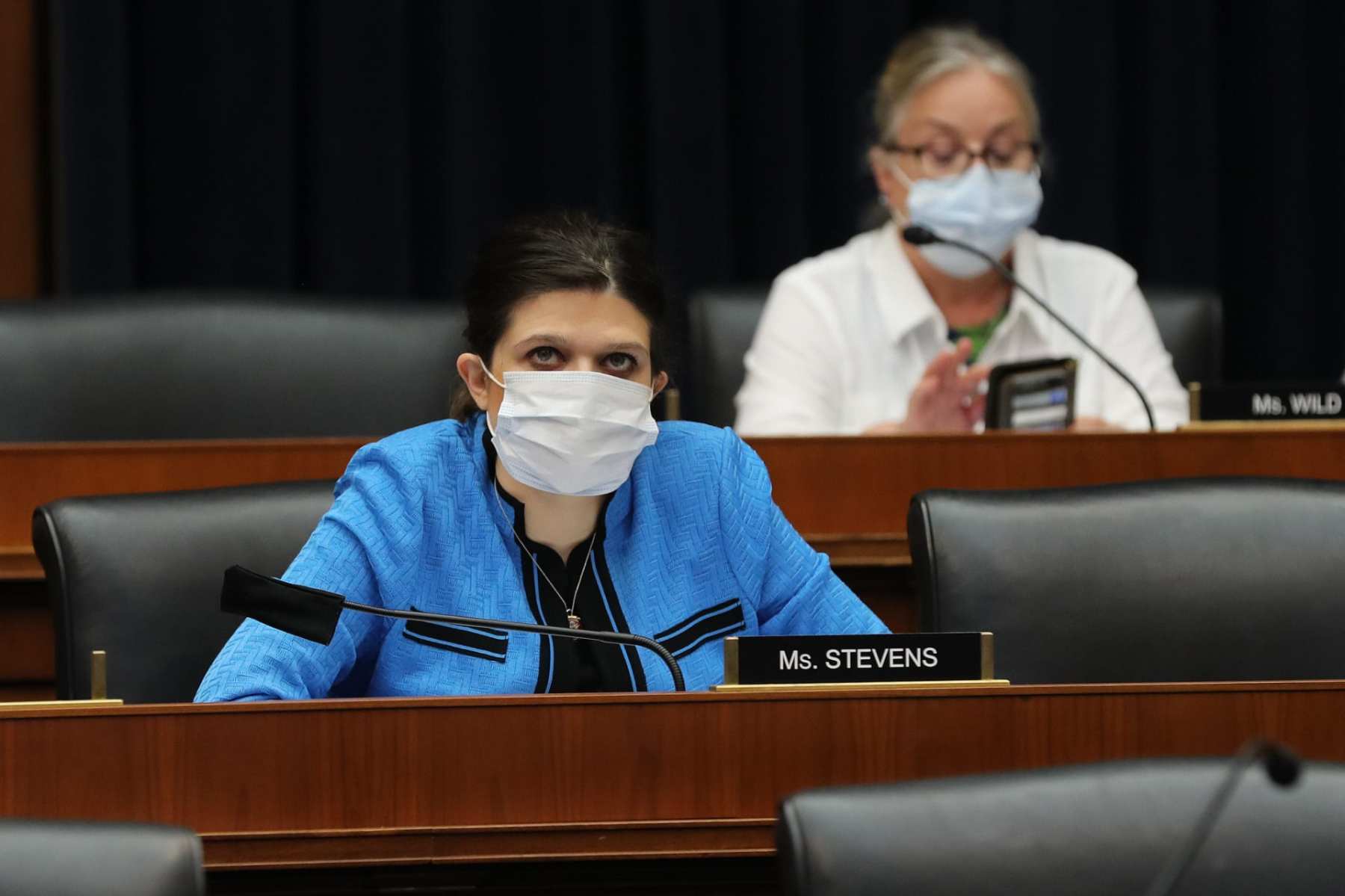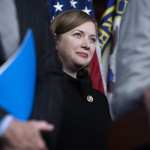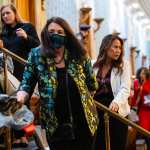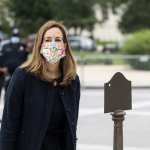About one month after pro-Trump rioters stormed the U.S. Capitol, The 19th reached out to all 143 women in the 117th Congress to ask about their experiences on January 6. Twenty-three shared their points of view from that day. We are also publishing each lawmaker’s full account of that day. Here is what Rep. Haley Stevens of Michigan told The 19th. The transcript has been lightly edited:
I’ll say this: Everyone was aware that January 6 was going to be a big day and a sensitive day given there were threats coming down from people who were angry about the results of the election and the activity that was going to be taking place that day. As a representative from southeast Michigan, I was made aware that a share of Republicans from District 11 were there at [President’s Trump’s] rally.
I was preparing for the Michigan election results to be contested. I went in early with my chief of staff around 8 or 8:30 a.m. I like getting to the office first thing. So we were there, getting ready to open up the floor for the day. My scheduler, who was also with us that day, had let me know that they had extra seats up in the gallery if I wanted to go up to the gallery and watch the floor proceedings.
Normally I like being on the floor of the House. I like watching democracy in action, listening to debate. But I was preparing for a long day and had a draft of my remarks and was continuing to work on my remarks and the potential for the Michigan Electoral College votes to be contested. I passed on going to the floor. I was at my desk on the fifth floor of Longworth with my remarks and the only real meeting I did that day was before the floor opened. We did a Zoom press conference as a Michigan delegation to talk about what was taking place in the Capitol that day and to stand by for the Michigan election results. All seven Democrats from Michigan attended; it was really nicely done. We all spoke from our heart with the facts before us and included what we were prepared to go into later as the results might be contested.
Shortly after that, we were still communicating as a delegation and a notification came through our computers that the building parallel to us, Cannon, was being evacuated due to a bomb threat. I talked to some of my colleagues in Cannon. One came over to my office because she didn’t know where else to go. We were notified that we should prepare to shelter in place in our office. I instructed my then-communications director to share this. I tweeted that the building next to mine has been evacuated, and I’m sheltering in place in my office — I can’t believe I have to write this. Some colleagues were in their offices, working from home, or on the House floor. I didn’t realize this at the time — I think I was the first member of Congress to tweet about it.
The evacuation of Cannon happened more than an hour before the siege of the Capitol. I was watching the television in my office. It was alarming and unusual that people were entering the building. “Had some deal been struck?” I thought. Then I saw the broken windows and realized they were storming the building. Right around 2:30 p.m., we started getting a lot of text messages — including from my fiancé back home in Michigan — as people watched the news. “Are you all right? Are you all right?”
The Cannon building was reopened, and they located the bomb and removed it. (Editor’s note: Bombs were placed at both the Republican National Committee and Democratic National Committee headquarters.) At the time, we were just hearing “suspicious package” and members made their way back to their offices. The cafeteria is right below me, so I went there as it was my only chance to eat something. I grabbed a salad and fries and I remember joking, “These fries could be the most dangerous thing that happens to me today, I don’t know.”
Watching what happened in the Capitol, unfolding in real time from my office in the Longworth building, I felt: “I’m safe up here, on the fifth floor of Longworth. No one is going to come up here.”
I did not hear too much. On occasion, I’d hear a loud bang. Earlier in the day, people were walking through the middle street between the Longworth and Cannon buildings. And that’s what I can see right outside my office. I could hear people as they were walking by there earlier in the day, but I couldn’t hear too too much. It also could’ve been because we had the TV on. We were in the office, so bewildered more than scared. That visual of armed guards in the chamber pointing guns at the door was really stark. I didn’t find out until later how many of my colleagues were on the House floor. If you talk to colleagues from states that would be contested, a lot were doing what I was doing: working from the office.
It took me about a handful of days afterwards when full reports were coming out to process everything that happened: the storming of the speaker’s office, confiscating of materials, insurrectionists, how Capitol Police were overtaken. I was just thinking about two police officers at the entrance of Longworth. They also could have been completely overtaken. This mob, if it wanted to, could have terrorized every floor of these office buildings.
Even though I don’t think I was concerned with security at the time, I’m more eyes wide open about the vulnerability of that day and how we were really under threat, under attack. It was terrible to watch what was happening to my colleagues on the House floor, the fact that several individuals from the mob were banging on the doors of the speaker’s lobby that leads to the House floor. They had to use reinforcements to keep that at bay and a woman lost her life. I just then proceeded to stay in my office until the first vote. I remember thinking, “I wonder if I can blow off steam at the gym.” There’s a House gym, but they’re definitely closed. I was just in my office, waiting for that first vote to be called.
I’ll conclude by sharing a story about the day before. A lot of times I go up to the House chamber and use the inside stairwell to the House floor, and on January 5 when I was walking up to the House floor, I had noticed a dried up ginkgo leaf on the marble steps. My parents used to run the landscaping business back in the day, which my dad still runs. My parents love trees and in particular, one of my dad’s favorite trees is the ginkgo tree. I thought, “How interesting that this leaf made it into the Capitol and is just sitting there.” I just walked over it.
So late on the 6th, when we were placing the first vote to reject the attempts to certify the votes, I think it was really important that we had continued with the work of the day and didn’t let them succeed. We finished the debate and were able to reject the attempt to decertify the Arizona election results.
At 1 o’clock in the morning or so — might have been before — as I was walking up the steps, the same ginkgo leaf was still there after the place was stormed by a mob. People had definitely run up those stairs. Oh my goodness gracious, I just couldn’t believe it. I took a picture of it, and showed it on my social media.
The ginkgo tree is this total symbol of resilience — one of the very few trees that survived the Hiroshima bombings in Japan. A very heralded tree. Someone said, “You should go back and get the leaf,” so I did. It’s a sign of hope and inspiration, and I want to continue that story.
The situation reminded me of my freshman year of college at American University in Washington D.C. It was 9/11. Again, they were different incidents, particularly in terms of the human casualty and perpetration. But the feeling was: I’m horrified at what I am seeing, and I myself don’t know what to do.
I’m horrified at what I am seeing, and I myself don’t know what to do.
Rep. Haley Stevens of Michigan
During 9/11, terrorists were trying to attack all Americans. In this instance, I’m a member of Congress and the Capitol is being attacked. And other members of Congress are under threat right now and that sort of means all of us are. I know obviously that no one was chanting my name, but I thought about what that would’ve meant for my colleagues who were on the House floor. They came within arm’s reach of the mob and insurrectionists. What would that have meant?
One of the things that really stuck with me is that this incredibly sacred space in democracy was vandalized and desecrated and torn apart by these individuals, who made that decision that day. That continues to be a really lasting wound as I walk through such a beautiful and historic place that hadn’t previously been overtaken.






